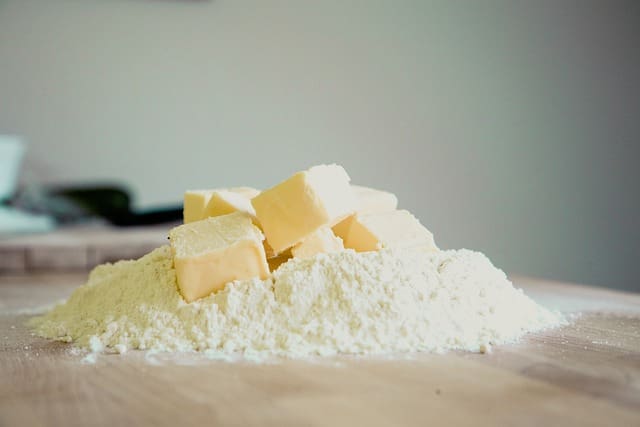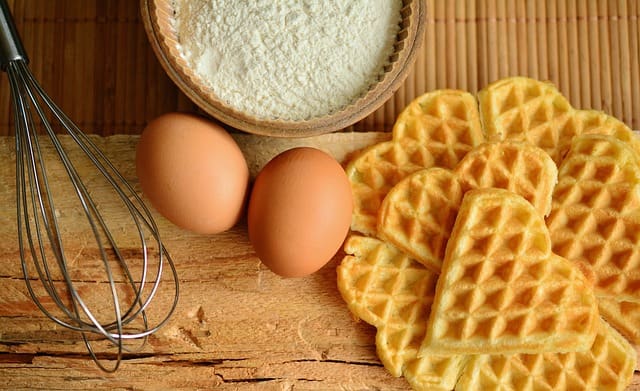Health
9 Amazing Gluten-Free Flour Alternatives for Mouthwatering Baking


When it comes to baking, the right flour is crucial to achieving the perfect texture and flavor. For those who follow a gluten-free diet, finding suitable alternatives can be a game-changer. While traditional wheat flour is a staple in baking, there are numerous gluten-free options that can yield equally delicious results.
From nutty almond flour to versatile coconut flour, the world of gluten-free baking offers a multitude of possibilities. Each alternative brings its unique properties to the table, opening up a new realm of mouthwatering creations.
Key Takeaways
- Almond flour and coconut flour are nutrient-rich and versatile options for gluten-free baking, offering healthy fats, protein, and fiber.
- Rice flour and oat flour are mild in flavor and have a fine texture, making them ideal for delicate and light-textured goods.
- Buckwheat flour has an impressive nutritional profile, high in protein and fiber, and adds a tender crumb and nutty flavor to baked goods.
- Tapioca flour, sorghum flour, arrowroot powder, and millet flour have unique properties that enhance the texture and flavor of gluten-free baked goods.
Almond Flour
When seeking a gluten-free flour alternative for baking, almond flour emerges as a versatile and nutritious option. Derived from ground almonds, this flour is rich in nutrients such as healthy fats, protein, and fiber. Almond flour is also low in carbohydrates, making it a suitable choice for individuals following a low-carb diet. Its mild, nutty flavor adds a delightful taste to baked goods. From cookies and cakes to bread and muffins, almond flour can be used in various recipes, offering a gluten-free option without compromising on taste or texture.
Furthermore, almond flour provides several health benefits. It is an excellent source of vitamin E, an antioxidant that supports skin health and immune function. Additionally, almond flour is packed with monounsaturated fats, which are beneficial for heart health. Studies have shown that consuming almonds and almond products may help lower cholesterol levels and reduce the risk of heart disease.
With its nutrient profile and culinary versatility, almond flour stands out as a top choice for those seeking a gluten-free flour alternative that promotes both freedom and well-being.


Coconut Flour
Coconut flour is a versatile and nutritious alternative to traditional flours, offering numerous benefits in gluten-free baking. Its high fiber and healthy fat content make it a popular choice for those seeking to boost the nutritional value of their baked goods.
From cakes to cookies, coconut flour can be used in a variety of recipes, adding a subtle sweetness and unique texture to the final product.
Benefits of Coconut Flour
Highlighting the nutritional advantages of coconut flour in baking emphasizes its potential to contribute to a balanced diet and meet the needs of individuals with dietary restrictions.
Coconut flour is rich in fiber, making it an excellent choice for promoting digestive health and supporting weight management.
It also contains beneficial fats, including medium-chain triglycerides, which have been associated with various health benefits such as improved brain function and heart health.


Additionally, coconut flour is a good source of protein, iron, and manganese, essential for energy production and overall well-being.
Its low glycemic index makes it suitable for individuals monitoring their blood sugar levels.
Furthermore, coconut flour is naturally gluten-free, making it an ideal option for those with celiac disease or gluten sensitivity.
Baking With Coconut Flour
With its numerous nutritional benefits and suitability for individuals with dietary restrictions, coconut flour presents a versatile and health-conscious option for baking a variety of delicious gluten-free treats.
Baking With Coconut Flour
- Absorbs Moisture: Coconut flour is highly absorbent, requiring more liquid than traditional flour. It’s essential to adjust the liquid content in recipes when using coconut flour to prevent dryness.
- Balancing Ingredients: Due to its unique properties, coconut flour often requires additional eggs or binding agents to achieve the desired texture and rise in baked goods.
- Flavor Enhancement: Coconut flour imparts a subtle coconut flavor to baked goods, adding a delightful tropical twist to recipes.
When baking with coconut flour, experimentation and adaptation are key to achieving mouthwatering gluten-free treats while harnessing the numerous benefits it offers.
Recipes With Coconut Flour
When incorporating coconut flour into your baking repertoire, it is essential to carefully select recipes that account for its unique absorbency and flavor profile. Coconut flour is highly absorbent and has a naturally sweet, nutty flavor, making it a great choice for a variety of baked goods.
One popular recipe using coconut flour is coconut flour pancakes. These pancakes are light, fluffy, and have a slightly sweet taste, making them a delightful breakfast option.
Another delicious recipe is coconut flour banana bread, which is moist, flavorful, and perfect for a healthy snack or dessert.
Additionally, coconut flour can be used to make delectable coconut flour muffins, adding a delicate coconut flavor to the classic treat.
When using coconut flour in recipes, it’s important to follow specific measurements and incorporate ample moisture to achieve the desired texture and taste.


Rice Flour
Rice flour, a gluten-free alternative, is a versatile option for baking due to its mild flavor and fine texture, making it suitable for a wide range of recipes. It is made from finely milled rice and comes in both white and brown varieties. Here are some reasons why rice flour is an amazing gluten-free flour alternative:
- Texture: Rice flour has a smooth and fine texture, which makes it ideal for baking delicate and light-textured goods such as cakes, muffins, and cookies.
- Neutral Flavor: Its mild flavor allows the other ingredients in the recipe to shine, making it a great choice for recipes where you don’t want the flour to overpower the other flavors.
- Versatility: Rice flour can be used on its own or in combination with other gluten-free flours to create a variety of baked goods, including bread, pancakes, and pastries.
Incorporating rice flour into your gluten-free baking repertoire can open up a world of culinary possibilities, allowing you to enjoy a wide range of mouthwatering treats while still adhering to a gluten-free diet.
Oat Flour
Derived from ground oats, oat flour is a nutritious and versatile gluten-free alternative that offers a subtly sweet flavor and a smooth texture, making it a great choice for a variety of baking applications. Oats are naturally gluten-free, making oat flour an excellent option for those with gluten sensitivities or celiac disease. Additionally, oat flour is rich in nutrients such as fiber, protein, and various vitamins and minerals, including manganese, phosphorus, and magnesium. Its nutritional profile adds value to baked goods, providing a healthier option compared to traditional wheat-based flours.
When using oat flour in baking, it is important to note that its slightly sweet flavor can complement a wide range of recipes, including cookies, muffins, pancakes, and bread. Its smooth texture helps create moist and tender baked goods. Due to its delicate flavor, oat flour can also be used as a thickening agent in sauces and gravies. When incorporating oat flour into recipes, it is advisable to adjust the liquid content as oat flour has a higher absorption rate compared to wheat flour.
When stored in an airtight container in a cool, dry place, oat flour can have a shelf life of up to three months, making it a convenient pantry staple for gluten-free baking enthusiasts.


Buckwheat Flour
Buckwheat flour is renowned for its impressive nutritional profile, boasting high levels of protein, fiber, and essential nutrients such as magnesium and manganese.
Beyond its nutritional benefits, buckwheat flour also offers unique baking properties, contributing to a tender crumb and a nutty, earthy flavor in baked goods.
Its distinct flavor profile sets it apart from other gluten-free flours, adding depth and complexity to a variety of recipes, from pancakes to breads and pastries.
Nutritional Benefits
A rich source of nutrients, buckwheat flour offers a variety of nutritional benefits that make it a valuable alternative for gluten-free baking.
Here are some of the key health benefits of buckwheat flour:


- High in Protein: Buckwheat flour is an excellent plant-based source of protein, containing all nine essential amino acids required by the body for growth, repair, and maintenance of tissues.
- Rich in Fiber: This flour is high in dietary fiber, which promotes digestive health, helps control blood sugar levels, and may lower the risk of heart disease.
- Packed with Essential Minerals: Buckwheat flour is a good source of essential minerals such as magnesium, iron, and zinc, which play crucial roles in various bodily functions, including energy production, immune system support, and red blood cell formation.
Incorporating buckwheat flour into your gluten-free baking can not only enhance the nutritional value of your baked goods but also contribute to a well-rounded diet.
Baking Properties
The nutritional benefits of buckwheat flour not only make it a valuable alternative for gluten-free baking but also give it distinct baking properties that contribute to the overall quality of baked goods.
Buckwheat flour has a rich, nutty flavor that adds depth to baked products, making it especially suitable for items like pancakes, muffins, and bread. Its unique composition also provides excellent binding properties, resulting in moist and tender textures in various baked goods.
Moreover, buckwheat flour is known for its high water absorption capacity, which helps maintain the moisture in baked items, extending their shelf life. Additionally, its natural sweetness allows for reduced sugar content in recipes.
These baking properties make buckwheat flour an exceptional choice for those seeking delectable gluten-free options without compromising on taste and texture.


Flavor Profile
With its distinctive nutty aroma and earthy undertones, buckwheat flour offers a robust flavor profile that enhances the overall sensory experience of baked goods. Its unique taste adds depth and character to various recipes, making it a popular choice for gluten-free baking. Here are some key flavor aspects of buckwheat flour:
- Nutty Aroma: Buckwheat flour emanates a pleasant nutty scent, which fills the kitchen while baking, adding an inviting element to the overall baking experience.
- Earthy Undertones: The flour’s earthy undertones bring a grounding and wholesome flavor to baked goods, creating a comforting and satisfying taste.
- Richness: Buckwheat flour contributes a rich, slightly sweet flavor that complements a wide range of ingredients, making it a versatile option for creating mouthwatering gluten-free treats.
Tapioca Flour
Occasionally overlooked in traditional baking, tapioca flour is a versatile gluten-free alternative that adds lightness and chewiness to baked goods. Derived from the cassava root, tapioca flour is a fine, powdery substance commonly used in gluten-free baking recipes. Its neutral flavor makes it a suitable addition to a wide variety of dishes, allowing the other flavors to shine through.
Tapioca flour’s unique properties contribute to the texture of baked goods, providing a desirable chewiness to bread, pizza crusts, and other baked items. It is also an excellent thickening agent for soups, sauces, and pie fillings.
One of the key benefits of tapioca flour is its ability to mimic the stretchiness of gluten, making it a popular choice for gluten-free baking. When used in combination with other gluten-free flours, such as almond flour or coconut flour, tapioca flour can help achieve a more balanced texture and improved structure in baked goods.
Additionally, tapioca flour is naturally free from common allergens, such as nuts and grains, making it a safe option for individuals with food sensitivities. For those seeking freedom in their dietary choices, tapioca flour offers a valuable solution for creating mouthwatering gluten-free treats.


Sorghum Flour
Derived from the Sorghum bicolor plant, sorghum flour is a nutritious gluten-free alternative that offers a mild, slightly sweet flavor profile for a variety of baking applications. This versatile flour is becoming increasingly popular due to its numerous health benefits and culinary uses.
Here are some key reasons to consider incorporating sorghum flour into your gluten-free baking repertoire:
- Nutrient-Rich: Sorghum flour is a good source of essential nutrients, including fiber, protein, and various vitamins and minerals such as B vitamins, iron, and antioxidants. This makes it a valuable addition to gluten-free diets, which can sometimes lack these nutrients.
- Versatile Baking Properties: Sorghum flour is known for its versatility in baking. It can be used on its own or blended with other gluten-free flours to create a wide range of baked goods, including bread, muffins, cookies, and cakes. Its subtle, sweet flavor makes it a great choice for both sweet and savory recipes.
- Improved Texture: When used in baking, sorghum flour can contribute to a softer, moister texture in gluten-free products, making it a desirable option for achieving excellent results in baked goods.
Sorghum flour’s nutritional profile, versatility, and texture-enhancing properties make it a standout choice for individuals seeking delicious gluten-free baking alternatives.
Arrowroot Powder
Sorghum flour provides a valuable gluten-free baking alternative. Similarly, arrowroot powder offers a versatile and beneficial option for enhancing the texture and structure of various baked goods. Derived from the tropical South American plant Maranta arundinacea, arrowroot powder is a gluten-free, grain-free, and paleo-friendly starch. It serves as an excellent thickening agent and can be used in combination with other gluten-free flours to create light and airy baked goods.
Arrowroot powder is known for its ability to impart a smooth and silky texture to baked goods, making it a popular choice for gluten-free recipes. It is also a great binding agent, which helps hold ingredients together in the absence of gluten. When used in baking, arrowroot powder can improve the overall mouthfeel of the final product, making it especially useful in cakes, cookies, and quick breads.


Additionally, arrowroot powder is neutral in flavor, allowing the natural taste of the ingredients to shine through without any starchy aftertaste. Its versatility and beneficial properties make arrowroot powder a valuable addition to any gluten-free pantry, offering freedom and flexibility in creating delicious, mouthwatering baked goods.
Millet Flour
Millet flour, a nutritious and versatile gluten-free option, is derived from the small-seeded grass of the Poaceae family and offers a valuable alternative for baking purposes. This ancient grain has been a staple in many cultures for thousands of years and is now gaining popularity as a gluten-free flour option due to its numerous health benefits and culinary versatility.
Benefits of Millet Flour:
- Nutrient-Rich: Millet is a good source of essential nutrients such as magnesium, iron, and phosphorus. It also contains significant levels of antioxidants and dietary fiber, making it a highly nutritious choice for gluten-free baking.
- Versatility: Millet flour has a delicate, slightly sweet flavor that works well in a variety of baked goods, including bread, muffins, and cookies. It can also be used as a thickening agent in soups, stews, and sauces.
- Gluten-Free: For individuals with gluten sensitivities or celiac disease, millet flour provides a safe and healthy alternative to traditional wheat flour, allowing them to enjoy a wide range of delicious baked goods without discomfort.
Incorporating millet flour into your baking repertoire not only adds nutritional value but also introduces a delightful flavor profile to your favorite recipes.
Frequently Asked Questions
Can These Gluten-Free Flour Alternatives Be Used as a 1:1 Substitute for Traditional Wheat Flour in Baking Recipes?
Yes, gluten-free flour alternatives can be used as a 1:1 substitute for traditional wheat flour in baking recipes. However, it’s important to consider the unique properties of each alternative and make adjustments accordingly.
Are There Any Specific Adjustments That Need to Be Made When Using These Gluten-Free Flours in Baking, Such as Altering the Liquid or Leavening Agents in a Recipe?
When using gluten-free flours in baking, specific adjustments may be necessary, such as altering the liquid or leavening agents. For example, coconut flour requires more liquid and eggs to achieve the right texture. Experimentation and recipe adaptations are essential for successful gluten-free baking.


What Are the Nutritional Benefits of Each of These Gluten-Free Flour Alternatives Compared to Traditional Wheat Flour?
The nutritional benefits of various gluten-free flour alternatives compared to traditional wheat flour vary. For instance, almond flour is high in healthy fats and protein, coconut flour is high in fiber, and rice flour offers a good source of carbohydrates and some protein.
Can These Gluten-Free Flours Be Used to Make Non-Baked Goods, Such as Thickening Sauces or Breading for Frying?
Yes, gluten-free flours like almond, coconut, and chickpea flour can be used for non-baked goods. They work well for thickening sauces, creating breaded coatings for frying, and can be incorporated into a variety of savory dishes.
Are There Any Potential Allergens or Cross-Contamination Risks to Be Aware of When Using These Gluten-Free Flour Alternatives?
When using gluten-free flour alternatives, it’s important to be aware of potential allergens and cross-contamination risks. Always check labels for allergen information and choose certified gluten-free products to minimize the risk of exposure for those with gluten sensitivities.


Hi, I’m Kyle Rivera, a news journalist and blog editor with the Daily Evening News. A TCU alum with a flair for storytelling, I spend my days uncovering impactful stories and my evenings exploring the realms of yoga, cycling, and whimsically bad poetry.
Travel is my escape; I’ve trekked from Tokyo’s neon lights to Iceland’s tranquil vistas. But no journey is complete without Mogli, my Golden Retriever, who’s redefining his breed standards in the most charming ways.
I love connecting with fellow travelers, yogis, cyclists, and anyone who enjoys a laugh at my poetic attempts. If you’re into stories that inspire, travel escapades, or just want to see what Mogli and I are up to, I’d love to hear from you on Instagram or Facebook. Let’s share tales and tips from around the globe!

